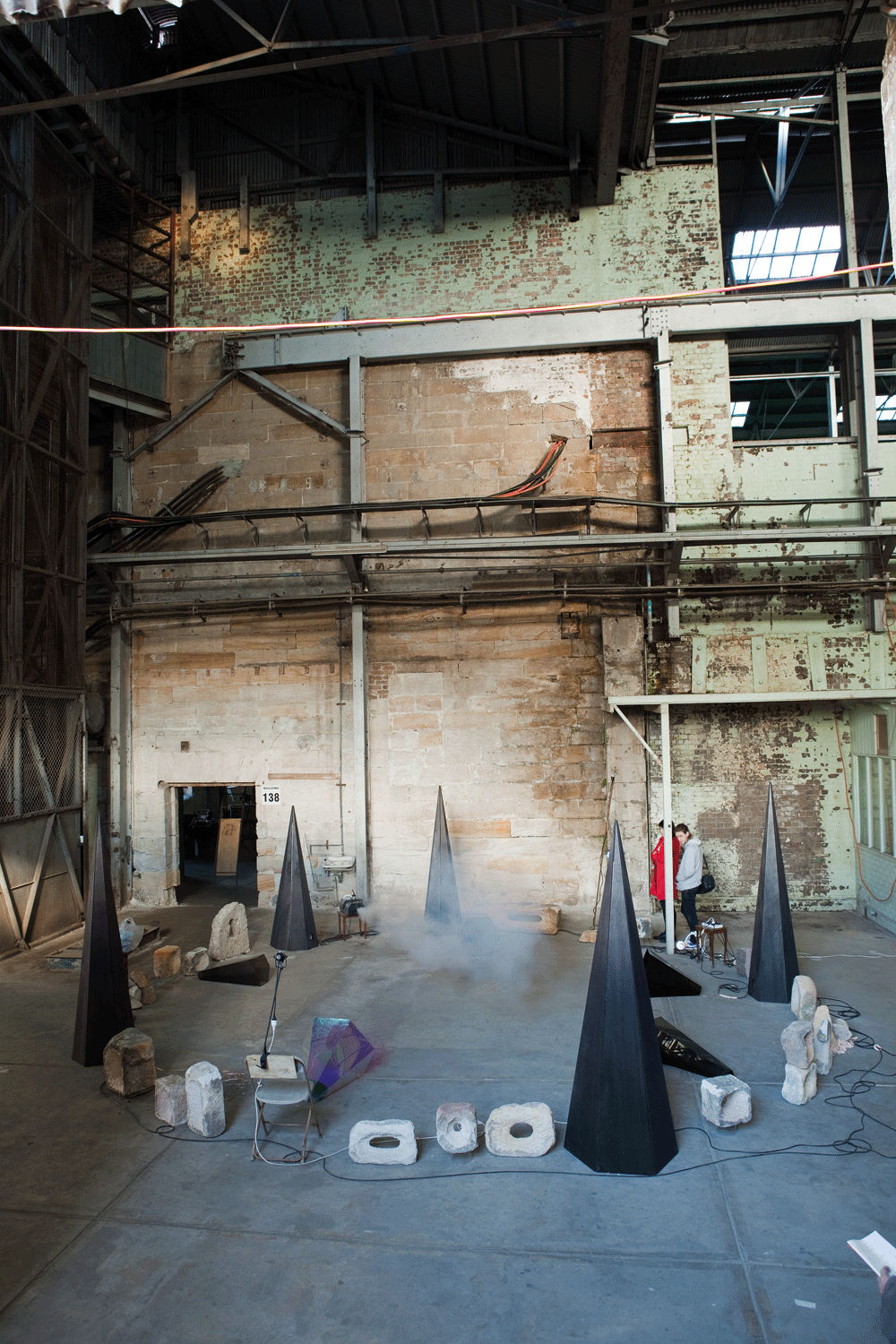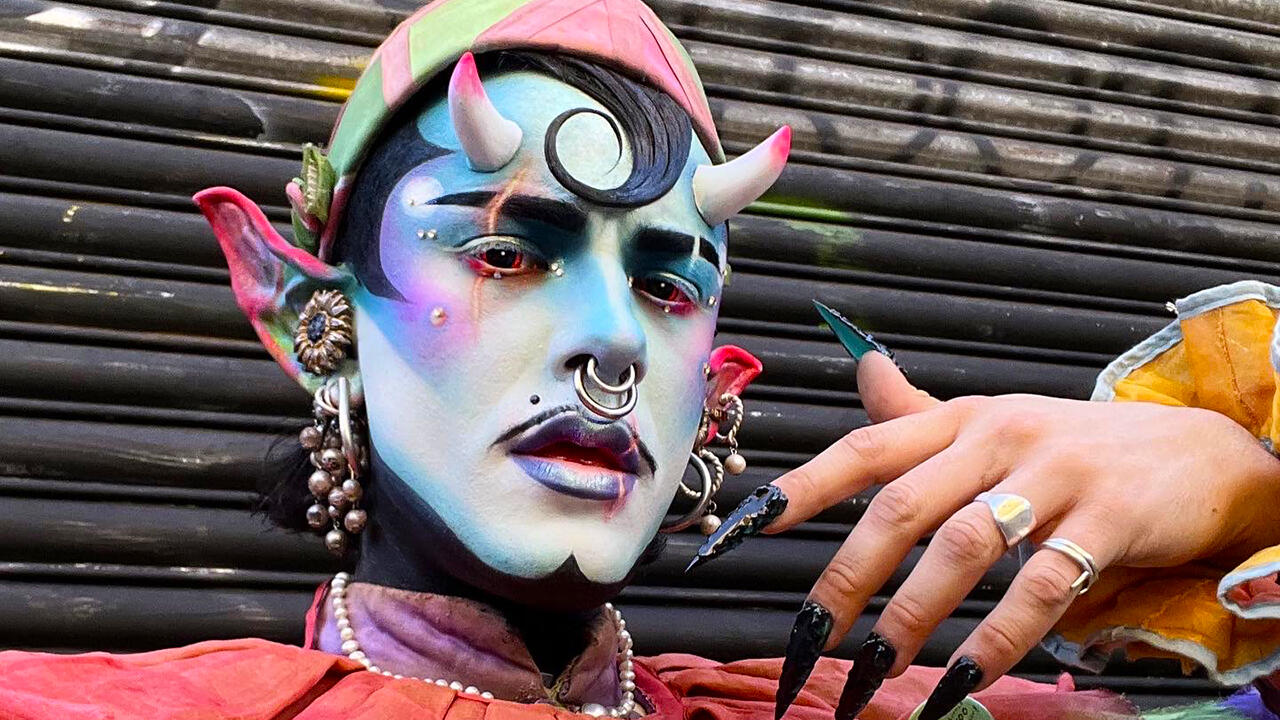Frontier Spirits
Myth, ghosts and borders in the work of Mikala Dwyer
Myth, ghosts and borders in the work of Mikala Dwyer

With their weird shifts in scale, precarious construction and mismatched objects, Mikala Dwyer’s installations can be both generous and threatening – places where memory, myth and magic crash into each other. The Australian artist’s early work in the 1990s combined post-punk glitziness with homespun materiality: make-up, high heels, sequinned material and half-smoked cigarettes appeared alongside vacuum cleaners, rubber bathmats and toilet seats. Gradually, these seemingly random elements developed into a tight formal vocabulary. When it became difficult to gauge where one work ended and another began the artist invented ‘holding patterns’ – structural devices that acted as conceptual restraints.¹ These were often circles or, as in her 1994 installation woops, stockings attached to beams and other supports – a soft architecture that seemed to prevent the work from escaping from the room.
Rather than defining solids, these holding patterns articulated empty spaces that viewers were invited to move into and through. Dwyer’s choice of permeable materials then, implied further voids within these larger porous frameworks. For example, in Hollowware & a few solids (1995), the artist employed organza, plastic, neoprene and cork, which – while suggesting solid sculptural volumes – were also vulnerable to penetration.² In recent years, she has pushed this interplay between permeability and obstruction even further, by creating completely transparent sculptures that nonetheless take up real space, such as Swamp Sculpture (2006): a twisted lump of clear plastic that floats around a swamp in Omi International Arts Center in upstate New York. She has also made several ‘hanging gardens’ (the first at Berlin’s Hamish Morrison Galerie in 2007): dangling landscapes in which living plants threaten to burst out of transparent containers.

These works all suggest something inside or beyond their basic materiality: alternative realities that can be seen and even touched, provided viewers are prepared to break spatial conventions in order to reach them. This is perhaps why Dwyer describes her installations as places where people can be ‘slightly badly behaved’.³ At times, this offer takes a literal form: for example, in Smoking, Drinking Sculpture (2006), visitors are permitted to flaunt regulations and smoke cigarettes and drink vodka – but only if they stay within the confines of the installation, which comprises a damaged rug and clear sculptures filled with domestic objects that seemed to defy gravity.
This desire to create spaces that collapse borders and invite transgression finds its strongest manifestation in Dwyer’s ‘occult’ works. In Jean’s OK (1994), for example, the artist arranged furniture and tape recorders in a format that implied a seance for the eccentric woman who lived and died in the Sydney hotel room where the piece was installed. She has also made circles of small, voodoo-like figurines (The Additions and the Subtractions, 2007), and created areas for palm readers to tell fortunes (Superstitious Scaffolding, 2005). Like mirrors of her installations, the occult rituals Dwyer references create charged fields of action; they are places that must be entered in order to cross into the parallel dimensions they promise.
Just before the 17th Biennale of Sydney last year, Dwyer had a six-month residency on Cockatoo Island in Sydney Harbour, an experience that made her exploration of ghosts more culturally specific. In the 19th century, the island was first a site of a penal settlement and then later a reformatory for young women. In two installations – at last year’s Biennale of Sydney and at Hamish Morrison Galerie – Dwyer created a complex iconography examining Australia’s often violent past and the way it haunts the country’s culture today. The work’s glittering veneer only thinly veils its underlying brutality.
Dwyer grew up in Sydney in a house built from sandstone quarried on Cockatoo Island. With her personal connections to the site swirling around, she created An Apparition of a Subtraction (2010) for the Biennale: a circle of zeroes that she says ‘grew out of time spent wandering about on Cockatoo Island for days and nights trying to find ghosts and dodging psychotic seagulls’.4 Dwyer has often used zeroes in her work, drawn to their ambiguous status as voids, escape routes and new beginnings. She has also explored the same form in a different context – the letter ‘O’ in a series of works entitled ‘IOU’ (the first in Dublin in 1996). In An Apparition of a Subtraction, the zeroes had even deeper resonances: they were made from sandstone blocks left over from the construction of her parents’ house. By carving cavities through the stones, she emulated the hard labour inflicted on the island’s convict population. She then overlaid the installation with a soundtrack: ‘I had this idea,’ she says, ‘that I could create a sonic object from the negative space of the stone, by layering the sound of the chipping so many times that it became dense again. And that by directing the sound into one spot through speaker cones, it would be possible to form an object that the ghosts could manifest through; a sort of summoning through the sound becoming matter again.’5 An Apparition of a Subtraction was a re-possession – of her own home and history, of the viewers who stepped into the circle and were subsequently ‘entered’ by Dwyer’s sonic spirits, and of Australia’s colonial past.
In Square Cloud Compound (2010) at Hamish Morrison Galerie, Dwyer raised more of Cockatoo Island’s ghosts.6 In the gallery’s main room she created an enclosure from squares of coloured fabric sewed into cubes and stretched by stockings attached to posts; these formed a circle and were shaped vaguely like gallows. Several were painted in prison stripes, while some were also adorned with lights or clunky handmade trinkets. A Mylar platform powered by silver balloons shaped like zeroes floated around the gallery’s smaller space, against a wall also painted in stripes. Nearby, were two looped videos that Dwyer shot on Cockatoo Island with her friend Justene Williams – Captain Thunderbolt’s Sisters and Redrockers (both 2010). In Captain Thunderbolt’s Sisters, Dwyer and Williams clamber around the walls of a circular bunker dressed in prison stripes, high heels and headpieces shaped like the 19th-century bushranger Ned Kelly’s helmet. Stories of the Kelly gang’s deeds, as well as their strange armour, turned him and his gang into not-quite-real tinmen who chased colonial Australians through their dreams. But although the women’s headgear refers to Kelly, the video’s title implies that they’re the fictional siblings of another famous bushranger, Captain Thunderbolt – a.k.a. Fred Ward. He was Cockatoo Island’s most notorious escapee, having slipped off the island in 1863 with the help of his lover Mary Ann Bugg, a part-Aboriginal woman and the daughter of an English convict; she allegedly swam through shark-infested waters to help Ward escape and thus embark on the crime spree that earned him the title of Captain Thunderbolt.

In evoking Bugg’s spirit, Dwyer and Williams don’t simply allude to Australia’s myths – they also feminize them, by re-imagining the role women played in the country’s outlaw and convict pasts. Bugg, as a woman who chose to break rules of colonial femininity, is a precursor of the young women who were later incarcerated on Cockatoo Island. Many of them were criminals or prostitutes who, through choice or circumstance, lived outside the law; many were probably brutalized by the guards. So the two artists in Captain Thunderbolt’s Sisters, who clang hammers against the bunker as they climb around it, could be seen to be trying to summon Bugg and other long-dead women through sound (as Dwyer did in An Apparition of a Subtraction), or looking for an escape route. The installation’s second video, Redrockers, intensifies the ambiguity between female entrapment and empowerment: the same pair crawl around a Cockatoo Island cave, this time dressed in red lamé. The cave as a location brings Square Cloud Compound back, full circle, to its Biennale of Sydney predecessor: it is yet another void, yet another form cut from rock, and yet another enclosure.
Dwyer is less interested in providing a complete account of Cockatoo Island’s history than she is in evoking its mythic status, its treatment of women and its presence in the architecture of her own life. She is also keen to emphasize that the violence the island encapsulates still permeates Australian culture. For example, she recently created a streetlamp in a lane in Sydney where a woman was raped. The artist intended it to be accompanied by a text by the Australian-born writer and academic Michael Taussig: ‘this is a lane with a name and a lamp in memory of the woman who survived being beaten and raped here. She happened to be lesbian. When the sun sets this lamp keeps vigil along with you who read this in silent meditation.’
However, local businesses objected to the text, so the lamp was erected without it, where – for now – it remains. At the time of writing, the project’s long-term future is unclear, although a petition in support of it is gathering momentum. Whatever happens, Dwyer promises not to let the issue go. For her, the lamp is an important monument in her city of birth; like the best of her recent work, it sheds light on dark histories.
1 For more on Dwyer's holding patterns, see Linda Michael's essay 'The Little Temples of Love for the Dead Things' in Mikala Dwyer, Museum of Contemporary Art, Sydney, 2000. pp. 8-9
2 Linda Michael has also commented on Dwyer's use of porous materials in this work: 'Rather than shoring up against the world these show a receptivity to change, even an uncertainty,' Ibid, p.8
3 Interview with the author, 29 November 2010
4 Email to the author, 28 November 2010
5 Ibid.
6 Square Cloud Compound was shown at Hamish Morrison Galerie, Berlin from 11 September - 23 October 2010
























